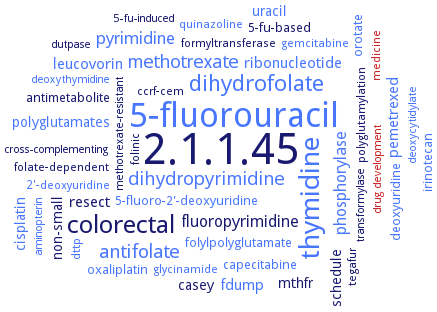2.1.1.45: thymidylate synthase
This is an abbreviated version!
For detailed information about thymidylate synthase, go to the full flat file.

Word Map on EC 2.1.1.45 
-
2.1.1.45
-
5-fluorouracil
-
thymidine
-
colorectal
-
dihydrofolate
-
antifolate
-
methotrexate
-
dihydropyrimidine
-
pyrimidine
-
fluoropyrimidine
-
phosphorylase
-
ribonucleotide
-
leucovorin
-
pemetrexed
-
resect
-
fdump
-
uracil
-
mthfr
-
casey
-
schedule
-
polyglutamates
-
non-small
-
cisplatin
-
folylpolyglutamate
-
deoxyuridine
-
oxaliplatin
-
5-fluoro-2'-deoxyuridine
-
antimetabolite
-
orotate
-
irinotecan
-
capecitabine
-
5-fu-based
-
ccrf-cem
-
folate-dependent
-
gemcitabine
-
folinic
-
formyltransferase
-
quinazoline
-
glycinamide
-
dttp
-
polyglutamylation
-
2'-deoxyuridine
-
tegafur
-
medicine
-
methotrexate-resistant
-
deoxycytidylate
-
cross-complementing
-
drug development
-
transformylase
-
5-fu-induced
-
dutpase
-
aminopterin
-
deoxythymidine
- 2.1.1.45
- 5-fluorouracil
- thymidine
- colorectal
- dihydrofolate
- antifolate
- methotrexate
- dihydropyrimidine
- pyrimidine
-
fluoropyrimidine
- phosphorylase
- ribonucleotide
- leucovorin
- pemetrexed
-
resect
- fdump
- uracil
- mthfr
-
casey
-
schedule
- polyglutamates
-
non-small
- cisplatin
- folylpolyglutamate
- deoxyuridine
- oxaliplatin
- 5-fluoro-2'-deoxyuridine
-
antimetabolite
- orotate
- irinotecan
- capecitabine
-
5-fu-based
-
ccrf-cem
-
folate-dependent
- gemcitabine
-
folinic
-
formyltransferase
- quinazoline
- glycinamide
- dttp
-
polyglutamylation
- 2'-deoxyuridine
-
tegafur
- medicine
-
methotrexate-resistant
- deoxycytidylate
-
cross-complementing
- drug development
-
transformylase
-
5-fu-induced
- dutpase
- aminopterin
- deoxythymidine
Reaction
Synonyms
BgDHFR-TS, bifunctional TS-DHFR, DFR-TS, DHFR-TS, DHFR�TS, dihydrofolate reductase-thymidylate synthase, dTMP synthase, HTS, human TS, LBRM_06_0830, methylenetetrahydrofolate:dUMP C-methyltransferase, More, Thy1, ThyA, thymidylate synthase, thymidylate synthase A, thymidylate synthase-dihydrofolate reductase, thymidylate synthetase, ThyX, TMP synthetase, TMPS, TS, TS-DHFR, TSase, TYMS, Y110A7A.4
ECTree
Advanced search results
General Stability
General Stability on EC 2.1.1.45 - thymidylate synthase
Please wait a moment until all data is loaded. This message will disappear when all data is loaded.
enzyme can be kept active for about 2-3 weeks in buffer F in presence of 0.001 mM methotrexate, dialysis against dilute buffer leads to rapid irreversible inactivation as does freeze-drying or simple freezing
-
enzyme is stabilized by addition of 20-120 mM dithiothreitol + bovine serum albumin
-
glycerol and Triton X-100 stabilize the enzyme
quite unstable
stable upon quick-freezing in liquid nitrogen in buffer containing 150 mM KCl
thawing of frozen enzyme leads to irreversible precipitation of the protein and total loss of activity, no successfully lyophilization possible
-
the wild type enzyme has an intracellular half-life of approximately 6 h after treatment with cycloheximide
-
treatment of zebrafish embryos with 5-fluorouracil increases the enzyme stability significantly, the half life of enzyme protein is about 2.7 times longer than in untreated embryos
-


 results (
results ( results (
results ( top
top





